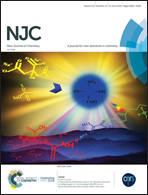A high photoluminescence sensor for selective detection of cartap based on functionalized VBimBF4B ionic liquid-strengthened sulfur-doped carbon nanodots†
Abstract
A high photoluminescence sensor based on functionalized room temperature ionic liquid-strengthened sulfur-doped carbon nanodots (IL-strengthened S-Cdots) is developed by a one-pot strategy. It facilitates real-time monitoring of cartap (CP) by a turn-off photoluminescence signal. The introduction of the ionic liquid 1-vinyl-3-butylimidazolium tetrafluoroborate (VBimBF4B) is beneficial to improve the photoluminescence quantum yield and stability of the photoluminescence sensor. VBimBF4B also uses methacrylic acid as the selected receptor to recognize cartap by the specific interaction of hydrogen bonding. The fluorescent response for cartap detection has a linear range between 1 μg L−1 and 100 μg L−1, and the detection limit is 0.86 μg L−1. The photoluminescence sensor shows better selectivity for cartap compared with other interference components. The developed method has been used for optosensing of cartap in complex food matrices, such as Chinese cabbage, cabbage, rapeseed, apple and pear, with a recovery of 78–99% and an observed RSD of 0.7–2.1% for three replicate measurements. These findings indicate the excellent ability of the prepared IL-strengthened S-Cdots to recognize cartap in complex food matrices and the potential of this method for application in cartap detection.



 Please wait while we load your content...
Please wait while we load your content...